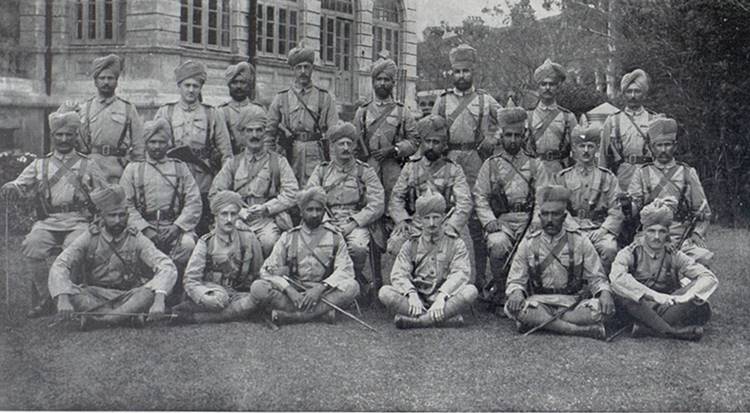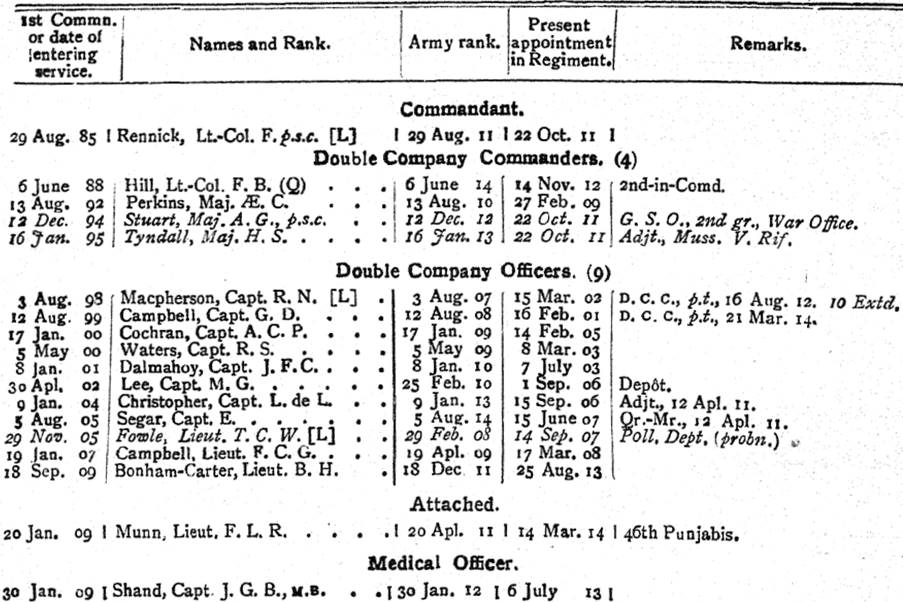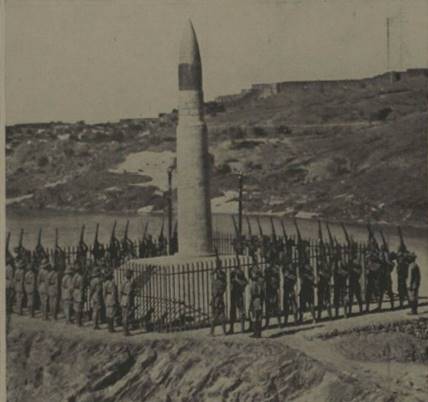This article looks at the 40th Pathans and will help you research those who served with the Regiment during the First World War. I have also written a series of guides to help you to research those who served in the Indian Army during the war:
The 40th Pathans in the First World War
Lineage: Raised by Lieutenant E. Dandridge at Shahjehanpur (Shahjahanpur) as the Shahjehanpur Levy in 1858. It became the 44th Regiment of Bengal Native Infantry in 1861 and the 40th Regiment of Bengal Native Infantry during the same year. Then the 40th (Shahjehanpur) Regiment of Bengal Native Infantry in 1864 and the 40th Regiment of Bengal Infantry in 1885. Then the 40th (Baluch) Regiment of Bengal Infantry in 1890 and the 40th (Pathan) Regiment of Bengal Infantry in 1892. The 40th Punjab Infantry in 1901 and the 40th Pathans in 1903 and the 5th Battalion 13th Punjab Regiment in 1922.
Class Composition in 1914: 2 Companies of Orakzais, 1 Company of Afridis, 1Company of Yusufzais, 2 Companies of Punjabi Musalmans and 2 Companies of Dogras. 1919: 1 Company of Orakzais, 1/2 a Company of Afridis, 1/2 a Company of Yusufzais, 1 Company of Punjabi Musalmans and 1 Company of Dogras.
Location in July 1914: The 40th Pathans was stationed at Hong Kong (China), having arrived from Alipore (Kolkata, India) on 1st May 1914.
The 40th Pathas was stationed at Hong Kong when the First World War began in August 1914. The Regiment had been inspected by Major-General E. S. May, Commanding Presidency Brigade for its confidential review report for 1913-14 who reported:
Turn out: The battalion is a good one and of remarkably fine appearance on parade.
Efficiency in drill: Satisfactory. Bayonet fighting, good.
Manoeuvre: Good.
Musketry: Good.
Fire discipline: Satisfactory.
Signalling: Satisfactory.
Personnel: The officers are a nice lot and know their work, while their relations with the men are cordial and sympathetic. The Indian Officers seem quite up to the standard and are intelligent and keen.
Discipline: Excellent.
Conduct: Excellent.
Health: Good.
Physique: Excellent.
Recruits: Good.
Equipment: Complete and in good order.
Interior Economy: Quite satisfactory. Due economy is practised regarding clothing deductions.
General efficiency: The regiment is well trained and fit for active service.
Confidential review reports on Indian Army units for 1913-1914: IOR/L/MIL/7/17023
The Regiment left Hong Kong on board the Hired Transport Basilan on 26 February 1915 for France and disembarked at Marseilles on 1 April 1915. Once in France, the Regiment joined the 8th (Jullunder) Infantry Brigade, 3rd (Lahore) Division. The Regiment suffered heavy casualties during the Second Battle of Ypres. Unfortunately, the 40th Pathans’ service on the Western Front was blighted by desertions including ten men on 4 October 1915. The extract below was taken from the October 1914 Indian Army List and recorded the British officers serving with the 40th Pathans.
In December 1915, the Regiment was withdrawn from France to East Africa, where it arrived at Mombasa on 9 January 1916. During its service in the East Africa Campaign, the Regiment was decimated by disease. The 40th Pathans served in East Africa until it was withdrawn to India in February 1918. Once back in India, the Regiment moved to Fatehgarh where it arrived on 17 February 1918. In 1922 the 40th Pathans became the 5th Battalion 13th Punjab Regiment.
The unveiling of the 40th Pathan’s distinctive war memorial at Attock, India (now Pakistan) in 1920. The memorial is still there, though it is in a dilapidated condition. This photograph is from The Illustrated London News, 10 July 1920.
War Diaries of the 40th Pathans
There are eight war diaries for the 40th Pathans and all have been digitized by the National Archives except the last covering the Third Anglo-Afghan War. To download the war diaries for a small fee click on the blue links below. As of February 2017, the last war diary can only be viewed at the National Archives. I have transcribed some of the entries below.
- Date: 26 February – 31 December 1915
- 8th Jullunder Infantry Brigade, 3rd (Lahore) Division
- Reference: WO95/3927/3
- Notes: A good war diary though between September and December very little occurred and the events of each month are written on a single page. There is a detailed patrol report carried out by three Indian soldiers on 18 May 1915.
- Date: 01 March – 30 September 1916
- 1st East African Division, East Africa
- Reference: WO95/5340/8
- Notes: Plenty of British and Indian officers mentioned throughout the war diary. September entries very long compared to the preceding months. Two appendices concerning Patrol reports one to Mkomba on 8 February, and another “Report of a 5 day patrol from Mwele 13-17 March 1916”.
- Date: January – February 1916
- Reference: WO95/5369/16
- See August – December 1917 below
- Date: 01 October 1916 – 28 November 1917
- 3rd East African Brigade, East Africa
- Reference: WO95/5341/13
- Notes: A good, detailed war diary.
- No.1 Column, Hanforce, East Africa
- Reference: WO95/5321/11
- Notes: A good war diary.
- Date: 01 June – 31 July 1917
- No.3 Column, Hanforce, East Africa
- Reference: WO95/5322/9
- Notes: A good war diary.
- Date: 01 August – 31 December 1917
- Lines of Communication, East Africa
- Reference: WO95/5369/17
- Notes: An unusual war diary as it contains January to February 1916 as well. January 1916 is a single page, the most interesting entry referring to the death of Major Carter VC who was “accidentally killed Mwele” [he shot himself]. Patrol report as an appendix.
- Date: 01 May – 31 August 1919
- 4th Infantry Brigade, 2nd Indian Division
- Reference: WO95/5409
- Notes:

Further Sources of information for the 40th Pathans
For information regarding the British and Indian officers who served with the 40th Pathans, the Indian Army List should be consulted. A very good resource for the Regiment are its annual confidential reports held at the British Library: Confidential Reports on Regiments etc. These reports also contain the annual confidential reports of the British officers serving with it. Though, when the 40th Pathans was abroad only its Depot and the officers serving with it are reported on.
History of the 5th Battalion (Pathans) 14th Punjab Regiment by Robert Sidney Waters. One of the best regimental histories produced, which unfortunately has not been republished since it was first published in 1936. This book can be found at the British Library, Imperial War Museum and other specialist institutions. See entry on Captain Thornton’s Private Papers below.
There is also another small book which just gives an outline of the Regiment’s services during the war and pales in comparison to the above volume. However, this book has been reprinted and can be found online and will be of use: 40th Pathans in the Great War by Anonymous.
The Imperial War Museum holds the private papers of Captain Reginald T Thornton Documents.14239 which includes a 37-page account of the Regiment’s service in East Africa. This may have been used for the foundation of the anonymous regimental history. There are a variety of letters and papers. The museum also holds 11 photographs of the Regiment by Thornton but I haven’t seen these: Photographs.8407-24. The British Library has a very interesting document which looks at the health of the 40th Pathans in East Africa: Collection 435/1278 Report on abnormal wastage of Indian troops in East Africa: health of 40th Pathans: IOR/L/MIL/7/18448.
Extracts from the War Diaries of the 40th Pathans
26 February – 31 December 1915, France, WO95/3927/3
26 April 1915 – Arrived Wieltche 10 am. Brigade halted there till 1.30 pm under shell fire. Orders to attack issued at 1 pm. At 1.50 pm advanced to Farm in open order under heavy shell fire. Massed behind Farm. Advanced to attack German trenches 1200 yards away under very heavy fire with enfilade fire from Machine Guns from right flank. Colonel Rennik hit at beginning. Attack reached to 150 yards from enemy’s trenches in some places closer. Enemy employed gas. French retired on left. Ferozepur Brigade fell back slightly. Troops lay down and entrenched. Heavy shellfire and machine gun fire. Lieutenant R. E. Thornton bob officer reached within 40 yards of enemy’s trenches was wounded. Troops held on in spite of fire.
10 pm. Regiment withdrawn. Split up in position and collected wounded. Collected at Farm. Marched to Cross Roads near Wieltche about 2.30 am.
28 June 1915 – Very long burst of hostile machine gun fire at 9 pm caused 3 casualties among ration party. After this, own machine gun reduced hostile sniping. Grass cutting and work on trench continued. Patrols as usual.
02 July 1915 – Hostile biplane circled across our front between 12.30 pm and 1.30 pm flying low on account of cloudy weather. Was fired at with machine gun and rifles and retired. No result of fire seen. One hostile sniper was brought down from a tree by Lance Naik Gul Mast B Company. Grass cutting, work on trenches and patrols as usual.
01 March – 31 May 1917, East Africa, WO95/5321/11
06 March 1917 – Kitambi – Strenuous efforts are being made to improve the insanitary conditions of this post, largely due to the carcasses of former pack mules. The mules we received at end of last month are now dying at the rate of three a day, and we have only a few left now: all the chargers are dead.
Deaths are now occurring from “horse sickness”, whereas formerly in the plains at Ngarambi mules died from tsetse fly bites. The A.P.M. has instituted a large crematorium, where a gang of buys are busily employed all day long cutting up and burning dead mules.
Owing to the efforts of the A.P.M. and M.O. the number of flies and odours are appreciably decreasing.
01 June – 31 July 1917, East Africa, WO95/5322/9
15 June 1917 – The enemy brought a gun to within range and shelled the camp. The naval guard ship replied and from the later information appears to have done some execution and successfully stopped an enemy infantry attack which was imminent but broke up in disorder under the naval gunfire.


